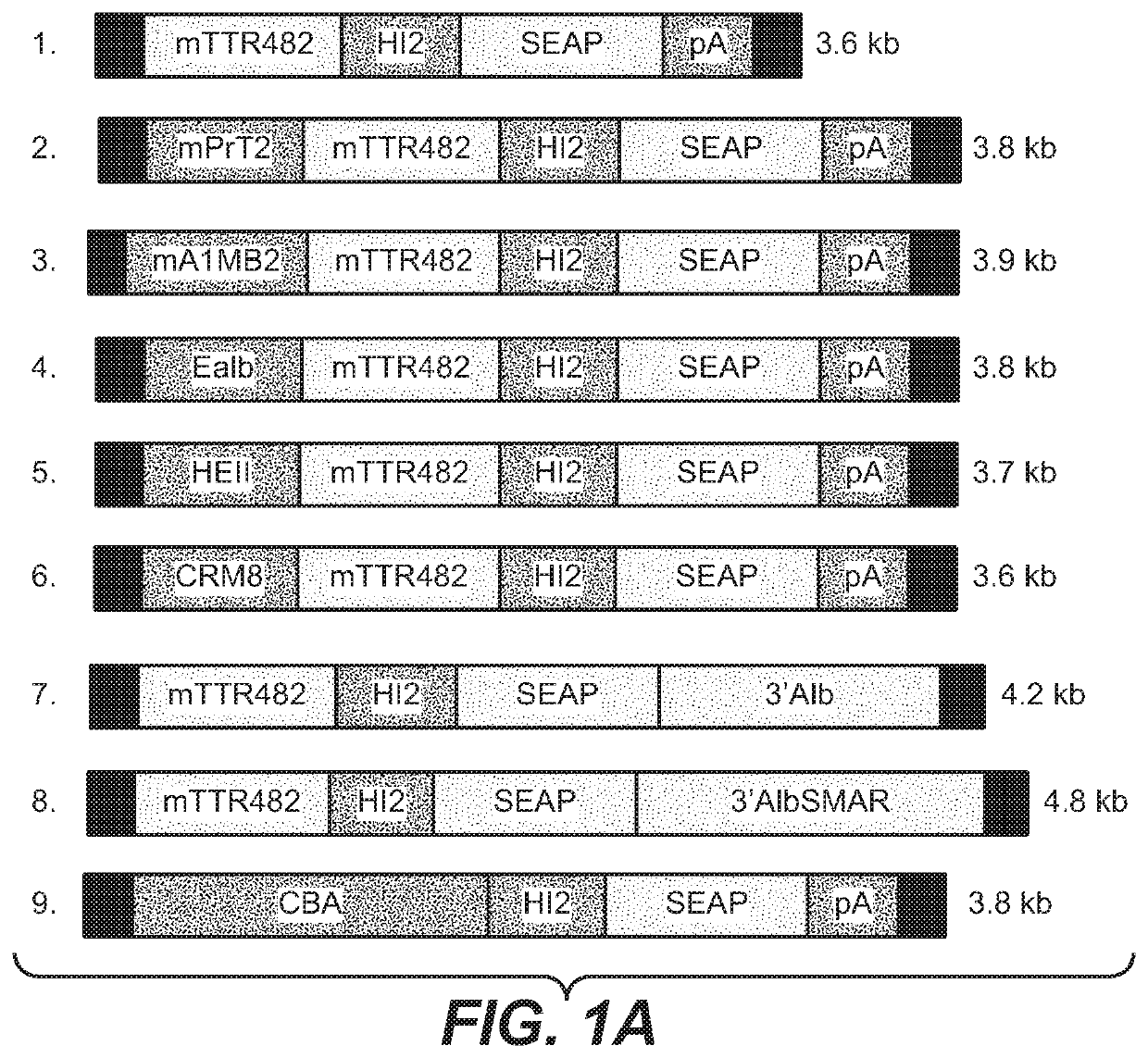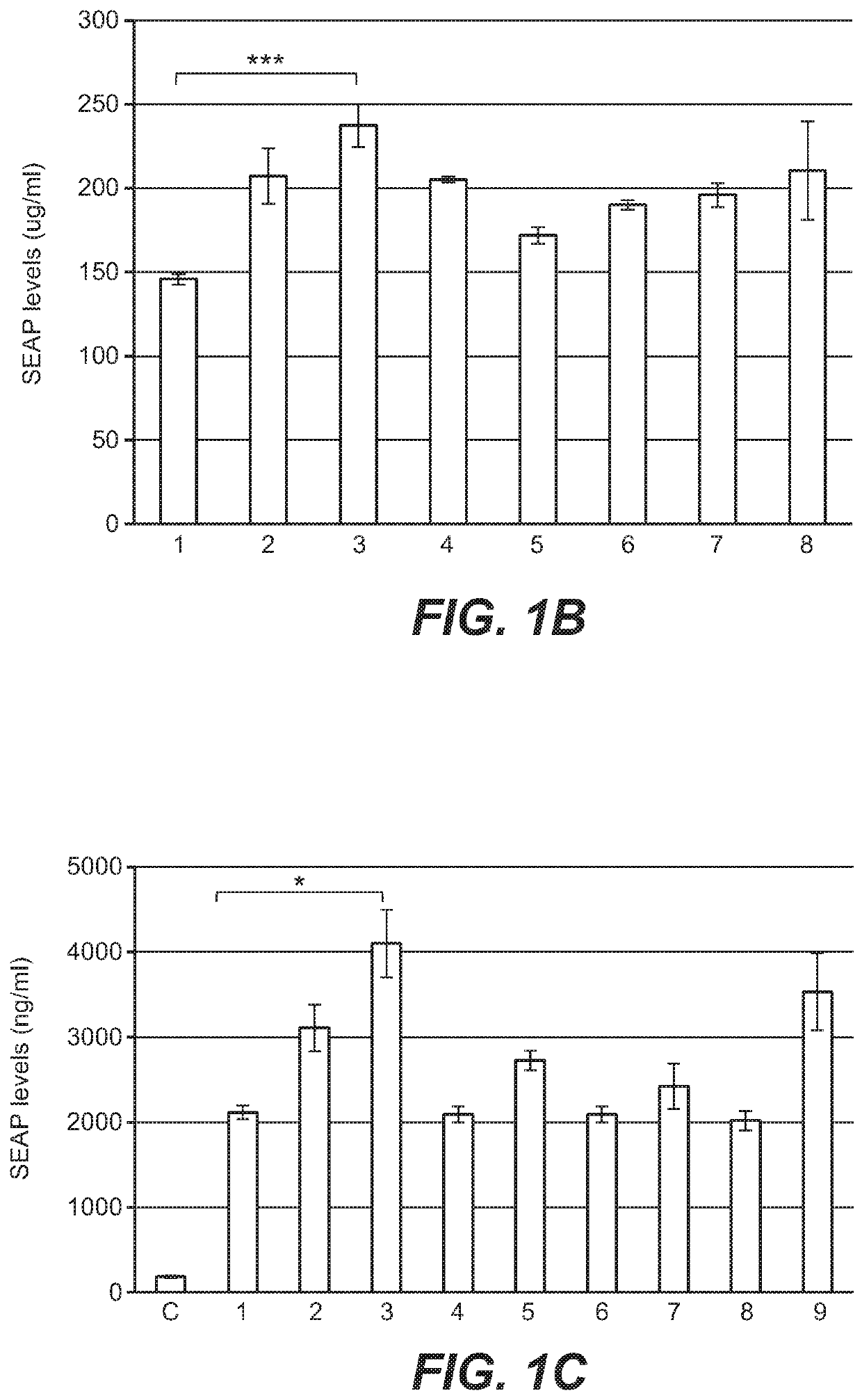Generation of improved human pah for treatment of severe pku by liver-directed gene replacement therapy
a technology of liver-directed gene replacement and human pah, which is applied in the field ofvariant phenylalanine hydroxylase polypeptides, can solve the problems of high incidence of attention deficit-hyperactivity disorder, difficult adherence to diet, and increase in non-compliance, so as to improve reduce vector doses, and improve the effect of protein stability and enzyme activity
- Summary
- Abstract
- Description
- Claims
- Application Information
AI Technical Summary
Benefits of technology
Problems solved by technology
Method used
Image
Examples
example 1
n of Liver-Specific Expression Cassette
[0339]The following study was conducted to develop a strong expression construct for expression of a transgene in the liver of an individual.
Materials and Methods for Examples 1-3
[0340]Construction of PAH Expression Cassettes and rAAV Vectors
[0341]To increase liver promoter strength, plasmid mTTR482-HI-hFVIII-BGHpA containing a mouse transthyretin (mTTR) promoter, an endogenous mTTR enhancer and a bovine growth hormone (BGH) polyadenylation (pA) site was used for additional modifications (Kyostio-Moore 2016, Nambiar 2017). In this plasmid, the FVIII cDNA was replaced with cDNA encoding secreted embryonic alkaline phosphatase (SEAP) and the existing intron was replaced with a 1069 bp chicken b-actin (CBA) / rabbit beta-globin hybrid intron. Various liver enhancer sequences were cloned upstream of the mTTR482 enhancer. These included modified prothrombin enhancer (mPrT2, two copies), modified alpha1-microbikunin (mA1MB2, two copies) (McEachern 2006...
example 3
n of hPAH Production from Codon-Optimized hPAH cDNAs
[0354]Previous published studies have shown poor efficacy with rAAV vectors encoding hPAH in PAHenu2 mice. To test whether improved efficacy could be obtained with a better produced hPAH, the effect of various codon usage was tested. For this, four different codon-optimized cDNAs for hPAH were generated based on different algorithms. The resulting sequences were cloned downstream from mTTR482 promoter and hPAH protein levels were evaluated in vitro and in vivo. Plasmid transfection into human Huh7 cells showed little differences among the hPAH cDNAs (all within 2-fold) (FIG. 5A). When expression plasmids were delivered into livers of normal C57BL / 6 mice via hydrodynamic injection, much larger differences were observed among the constructs (FIG. 5B). In particular, expression plasmid with hPAH cDNA generated by GA algorithm resulted in 7-fold higher FLAG-tagged protein detection in the liver lysates compared to that with plasmid wit...
example 4
n of Human PAH and Mouse PAH In Vitro and In Vivo
Methods
Plasmid Vectors and Recombinant AAV Generation.
[0355]The generation of liver-specific promoters (LP1 and mTTR482), hybrid intron, polyadenylation sites (bovine growth hormone [BGH] and simian virus 40 [SV40]) are known in the art and have been described in Nathwani (2012) and Nambiar (2017). Various plasmid vectors with liver-specific or chicken b-actin (CBA) promoter, hybrid intron, cDNAs encoding full-length (FL) human (h) or mouse (m) PAH and BGH polyA were constructed. Expression cassettes with double-truncated forms of mPAH and hPAH (DT; amino acids 103-428) or with various hybrid constructs were also generated. Amino acid modifications in hPAH-DT and in mPAH were evaluated in plasmid vectors with CBA promoter, hybrid intron, PAH-DT and BGH polyA. Amino acid changes in variants (V) of PAH-DT amino acid sequence were generated by synthesizing altered DNA sequence or introducing changes by site-directed mutagenesis (Genscrip...
PUM
 Login to View More
Login to View More Abstract
Description
Claims
Application Information
 Login to View More
Login to View More - R&D
- Intellectual Property
- Life Sciences
- Materials
- Tech Scout
- Unparalleled Data Quality
- Higher Quality Content
- 60% Fewer Hallucinations
Browse by: Latest US Patents, China's latest patents, Technical Efficacy Thesaurus, Application Domain, Technology Topic, Popular Technical Reports.
© 2025 PatSnap. All rights reserved.Legal|Privacy policy|Modern Slavery Act Transparency Statement|Sitemap|About US| Contact US: help@patsnap.com



